Design of a Highly Compatible Underwater Wireless Power Transfer Station for Seafloor Observation Equipment
Abstract
1. Introduction
2. Design and Analysis of the Station and the Transmitter
2.1. Overall Design of the Underwater WPT Station
2.2. Magnetic Field Distribution Analysis for the Transmitters
2.3. Transmitter Layout Structure
3. Transmitter Parameter Optimization
3.1. Parameter Optimization Principles
3.2. Optimization Result Analysis
4. Circuit Configuration and Characteristic Analysis
4.1. Circuit Configuration
4.2. Circuit Characteristics Analysis
5. Underwater WPT Station Assembly and Experiments
5.1. Station Prototype Assembly
5.2. Experiment Results
6. Conclusions
Author Contributions
Funding
Institutional Review Board Statement
Informed Consent Statement
Data Availability Statement
Conflicts of Interest
References
- Favali, P.; Beranzoli, L. Seafloor Observatory Science: A Review. Ann. Geophys. 2006, 49, 515–567. [Google Scholar] [CrossRef]
- Lu, F.; Zhou, H.; Peng, X.; Yue, J.; Wang, P. Technical preparation and prototype development for long-term cabled seafloor observatories in Chinese marginal seas. In Seafloor Observatories: A New Vision of the Earth from the Abyss; Favali, P., Beranzoli, L., De Santis, A., Eds.; Springer: Berlin/Heidelberg, Germany, 2015; pp. 503–529. [Google Scholar]
- Painter, H.; Flynn, J. Current and Future Wet-Mate Connector Technology Developments for Scientific Seabed Observatory Applications. In Proceedings of the OCEANS 2006, Singapore, 18–21 September 2006; pp. 1–6. [Google Scholar]
- Teeneti, C.R.; Truscott, T.T.; Beal, D.N.; Pantic, Z. Review of Wireless Charging Systems for Autonomous Underwater Vehicles. IEEE J. Ocean. Eng. 2021, 46, 68–87. [Google Scholar] [CrossRef]
- Zhang, B.; Xu, W.; Lu, C.; Lu, Y.; Wang, X. Review of low-loss wireless power transfer methods for autonomous underwater vehicles. IET Power Electron. 2022, 15, 775–788. [Google Scholar] [CrossRef]
- Cheng, Z.; Lei, Y.; Song, K.; Zhu, C. Design and Loss Analysis of Loosely Coupled Transformer for an Underwater High-Power Inductive Power Transfer System. IEEE Trans. Magn. 2015, 51, 1–10. [Google Scholar] [CrossRef]
- Kan, T.; Mai, R.; Mercier, P.P.; Mi, C.C. Design and Analysis of a Three-Phase Wireless Charging System for Lightweight Autonomous Underwater Vehicles. IEEE Trans. Power Electron. 2018, 33, 6622–6632. [Google Scholar] [CrossRef]
- Cai, C.; Zhang, Y.; Wu, S.; Liu, J.; Zhang, Z.; Jiang, L. A Circumferential Coupled Dipole-Coil Magnetic Coupler for Autonomous Underwater Vehicles Wireless Charging Applications. IEEE Access 2020, 8, 65432–65442. [Google Scholar] [CrossRef]
- Cai, C.; Wu, S.; Zhang, Z.; Jiang, L.; Yang, S. Development of a Fit-to-Surface and Lightweight Magnetic Coupler for Autonomous Underwater Vehicle Wireless Charging Systems. IEEE Trans. Power Electron. 2021, 36, 9927–9940. [Google Scholar] [CrossRef]
- Wu, S.; Cai, C.; Chai, W.; Li, J.; Cui, Q.; Yang, S. Uniform Power IPT System With Quadruple-Coil Transmitter and Crossed Dipole Receiver for Autonomous Underwater Vehicles. IEEE Trans. Ind. Appl. 2022, 58, 1289–1297. [Google Scholar] [CrossRef]
- Yan, Z.; Zhang, Y.; Song, B.; Zhang, K.; Kan, T.; Mi, C. An LCC-P Compensated Wireless Power Transfer System with a Constant Current Output and Reduced Receiver Size. Energies 2019, 12, 172. [Google Scholar] [CrossRef]
- Feezor, M.D.; Sorrell, F.Y.; Blankinship, P.R. An interface system for autonomous undersea vehicles. IEEE J. Ocean. Eng. 2001, 26, 522–525. [Google Scholar] [CrossRef]
- Bradley, A.M.; Feezor, M.D.; Singh, H.; Sorrell, F.Y. Power systems for autonomous underwater vehicles. IEEE J. Ocean. Eng. 2001, 26, 526–538. [Google Scholar] [CrossRef]
- Kawasaki, T.; Noguchi, T.; Fukasawa, T.; Hayashi, S.; Shibata, Y.; Limori, T.; Okaya, N.; Fukui, K.; Kinoshita, M. “Marine Bird”, a new experimental AUV—results of docking and electric power supply tests in sea trials. In Proceedings of the Oceans ‘04 MTS/IEEE Techno-Ocean ‘04 (IEEE Cat. No.04CH37600), Kobe, Japan, 9–12 November 2004; pp. 1738–1744. [Google Scholar]
- Hobson, B.W.; McEwen, R.S.; Erickson, J.; Hoover, T.; McBride, L.; Shane, F.; Bellingham, J.G. The Development and Ocean Testing of an AUV Docking Station for a 21” AUV. In Proceedings of the OCEANS 2007, Vancouver, BC, Canada, 29 September–4 October 2007; pp. 1–6. [Google Scholar]
- McEwen, R.S.; Hobson, B.W.; McBride, L.; Bellingham, J.G. Docking Control System for a 54-cm-Diameter (21-in) AUV. IEEE J. Ocean. Eng. 2008, 33, 550–562. [Google Scholar] [CrossRef]
- McGinnis, T.; Henze, C.P.; Conroy, K. Inductive Power System for Autonomous Underwater Vehicles. In Proceedings of the OCEANS 2007, Vancouver, BC, Canada, 29 September–4 October 2007; pp. 1–5. [Google Scholar]
- Huang, Y.; Fang, C.; Li, X. Contactless power and data transmission for underwater sensor nodes. EURASIP J. Wirel. Commun. Netw. 2013, 2013, 81. [Google Scholar] [CrossRef]
- Xu, J.; Li, X.; Li, H.; Xie, Z.; Ma, Q. Maximum Efficiency Tracking for Multitransmitter Multireceiver Wireless Power Transfer System on the Submerged Buoy. IEEE Trans. Ind. Electron. 2022, 69, 1909–1919. [Google Scholar] [CrossRef]
- Zhou, J.; Li, D.-J.; Chen, Y. Frequency selection of an inductive contactless power transmission system for ocean observing. Ocean Eng. 2013, 60, 175–185. [Google Scholar] [CrossRef]
- Sato, Y.; Maki, T.; Masuda, K.; Matsuda, T.; Sakamaki, T. Autonomous docking of hovering type AUV to seafloor charging station based on acoustic and visual sensing. In Proceedings of the 2017 IEEE Underwater Technology (UT), Busan, Republic of Korea, 21–24 February 2017; pp. 1–6. [Google Scholar]
- He, Z.; Wang, Y.; Ding, L.; Nie, X. Research on three-dimensional omnidirectional wireless power transfer system for subsea operation. In Proceedings of the OCEANS 2017, Aberdeen, UK, 19–22 June 2017; pp. 1–5. [Google Scholar]
- Wang, T.; Zhao, Q.; Yang, C. Visual navigation and docking for a planar type AUV docking and charging system. Ocean Eng. 2021, 224, 108744. [Google Scholar] [CrossRef]
- Yang, C.; Wang, T.; Chen, Y. Design and analysis of an omnidirectional and positioning tolerant AUV charging platform. IET Power Electron. 2019, 12, 2108–2117. [Google Scholar] [CrossRef]
- Huang, L.; Lyu, F. Compact Low-Velocity Ocean Current Energy Harvester Using Magnetic Couplings for Long-Term Scientific Seafloor Observation. J. Mar. Sci. Eng. 2020, 8, 410. [Google Scholar] [CrossRef]
- Lyu, F.; Cai, T.; Huang, L. Harvesting Weak Ocean Current Energy for Resident Unmanned Underwater Vehicles. In Proceedings of the OCEANS 2021: San Diego—Porto, San Diego, CA, USA, 20–23 September 2021; pp. 1–6. [Google Scholar]
- Wang, T.; Yang, C. Magnetic field optimization for high-positioning-tolerant wireless charging platforms. J. Power Electron. 2020, 20, 22–33. [Google Scholar] [CrossRef]
- Zhong, W.X.; Liu, X.; Hui, S.Y.R. A Novel Single-Layer Winding Array and Receiver Coil Structure for Contactless Battery Charging Systems With Free-Positioning and Localized Charging Features. IEEE Trans. Ind. Electron. 2011, 58, 4136–4144. [Google Scholar] [CrossRef]
- Sato, N.; Kifune, H.; Komeda, S. A coil layout of wireless power transfer systems based on multicoil arrangement for underwater vehicles. Electr. Eng. Jpn. 2019, 207, 38–48. [Google Scholar] [CrossRef]
- Pahlavan, S.; Shooshtari, M.; Jafarabadi Ashtiani, S. Star-Shaped Coils in the Transmitter Array for Receiver Rotation Tolerance in Free-Moving Wireless Power Transfer Applications. Energies 2022, 15, 8643. [Google Scholar] [CrossRef]
- Mirbozorgi, S.A.; Maghsoudloo, E.; Bahrami, H.; Sawan, M.; Gosselin, B. Multi-resonator arrays for smart wireless power distribution: Comparison with experimental assessment. IET Power Electron. 2020, 13, 4183–4193. [Google Scholar] [CrossRef]
- Zhou, J.; Guo, K.; Chen, Z.; Sun, H.; Hu, S. Design considerations for contact-less underwater power delivery: A systematic review and critical analysis. Wirel. Power Transf. 2020, 7, 76–85. [Google Scholar] [CrossRef]
- Budhia, M.; Boys, J.T.; Covic, G.A.; Huang, C.Y. Development of a Single-Sided Flux Magnetic Coupler for Electric Vehicle IPT Charging Systems. IEEE Trans. Ind. Electron. 2013, 60, 318–328. [Google Scholar] [CrossRef]
- Sampath, J.P.K.; Alphones, A.; Vilathgamuwa, D.M. Figure of Merit for the Optimization of Wireless Power Transfer System Against Misalignment Tolerance. IEEE Trans. Power Electron. 2017, 32, 4359–4369. [Google Scholar] [CrossRef]
- Kiani, M.; Ghovanloo, M. A Figure-of-Merit for Designing High-Performance Inductive Power Transmission Links. IEEE Trans. Ind. Electron. 2013, 60, 5292–5305. [Google Scholar] [CrossRef]
- Liang, B.; Mao, Z.; Zhang, K.; Liu, P. Analysis and Optimal Design of a WPT Coupler for Underwater Vehicles Using Non-Dominated Sorting Genetic Algorithm. Appl. Sci. 2022, 12, 2015. [Google Scholar] [CrossRef]
- Zhu, Q.; Wang, L.; Guo, Y.; Liao, C.; Li, F. Applying LCC Compensation Network to Dynamic Wireless EV Charging System. IEEE Trans. Ind. Electron. 2016, 63, 6557–6567. [Google Scholar] [CrossRef]
- Sohn, Y.H.; Choi, B.H.; Lee, E.S.; Lim, G.C.; Cho, G.H.; Rim, C.T. General Unified Analyses of Two-Capacitor Inductive Power Transfer Systems: Equivalence of Current-Source SS and SP Compensations. IEEE Trans. Power Electron. 2015, 30, 6030–6045. [Google Scholar] [CrossRef]
- Wen, H.; Zhang, K.; Yan, Z.; Song, B. A novel electromagnetic actuator in an inductive power transmission system for autonomous underwater vehicle. Adv. Mech. Eng. 2018, 10, 1687814018797421. [Google Scholar] [CrossRef]

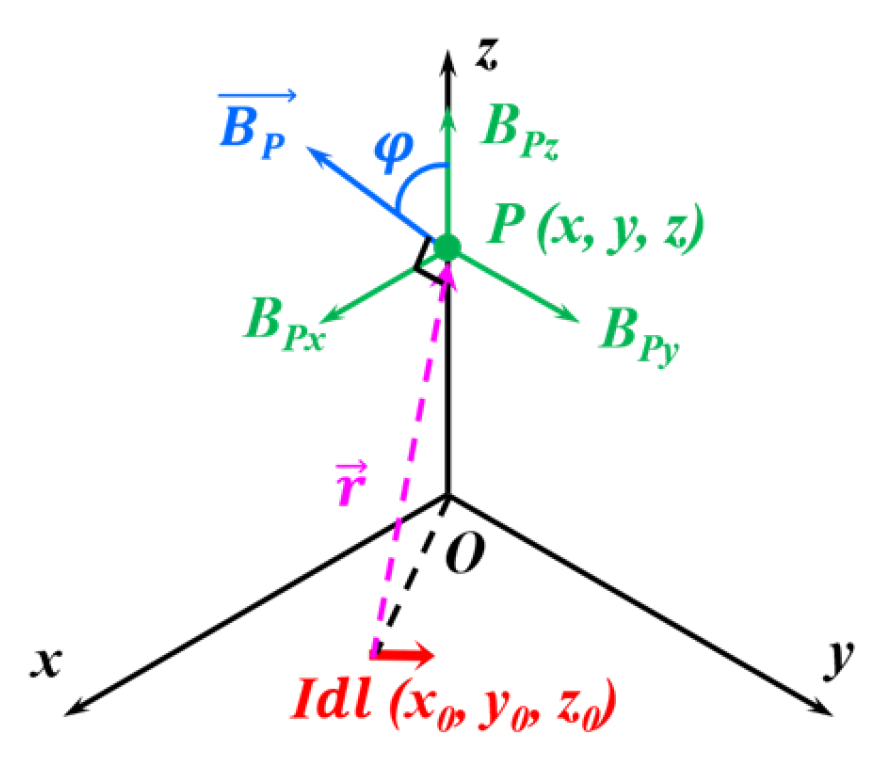
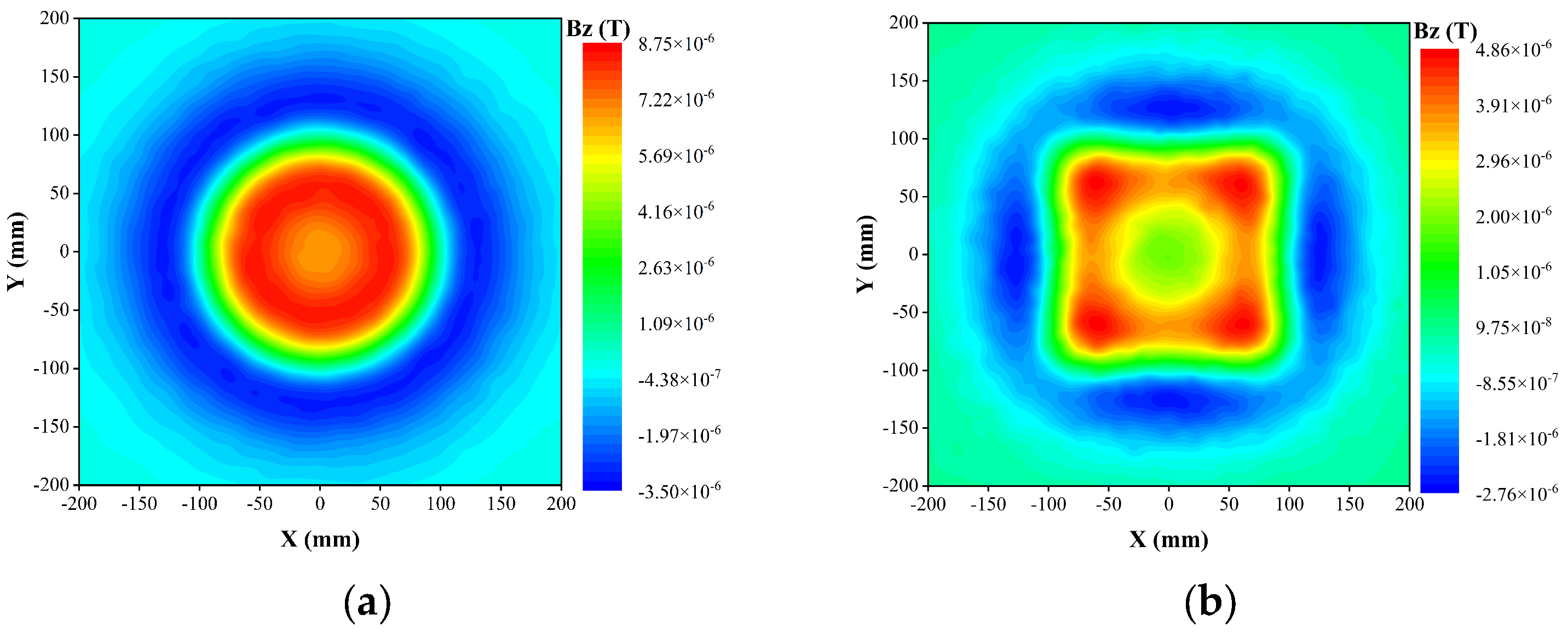
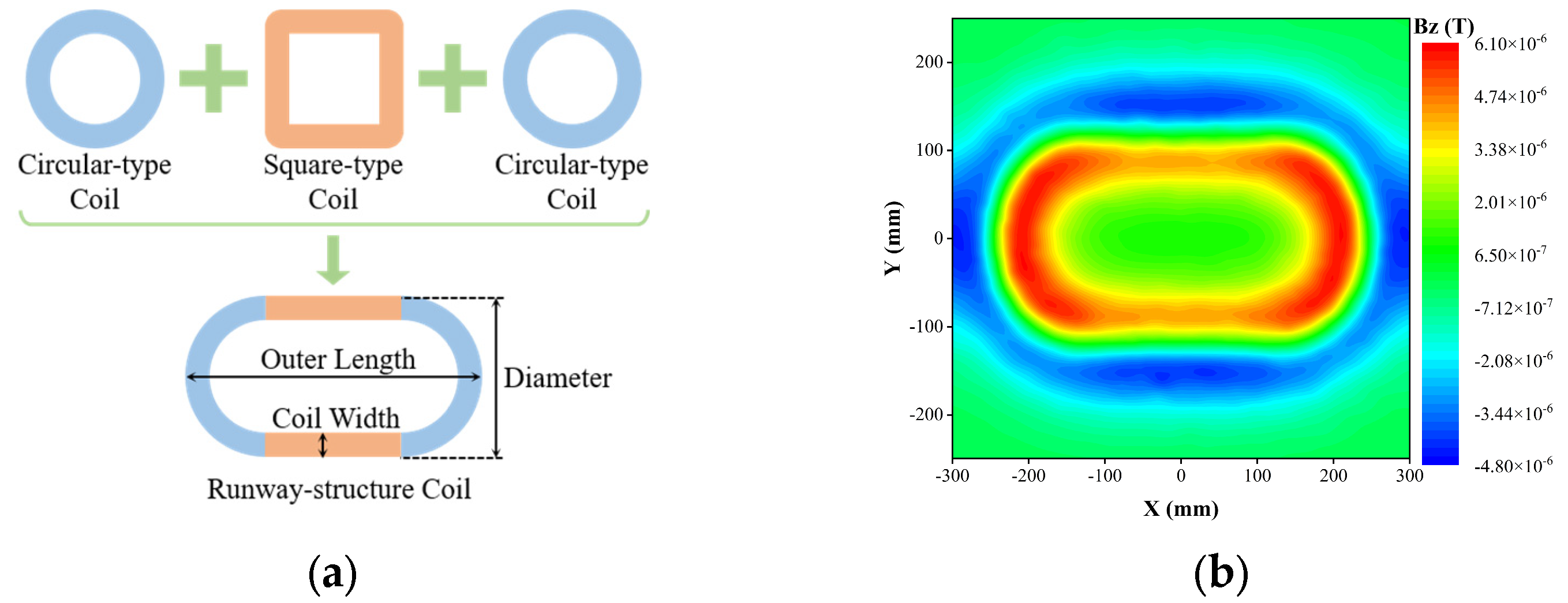

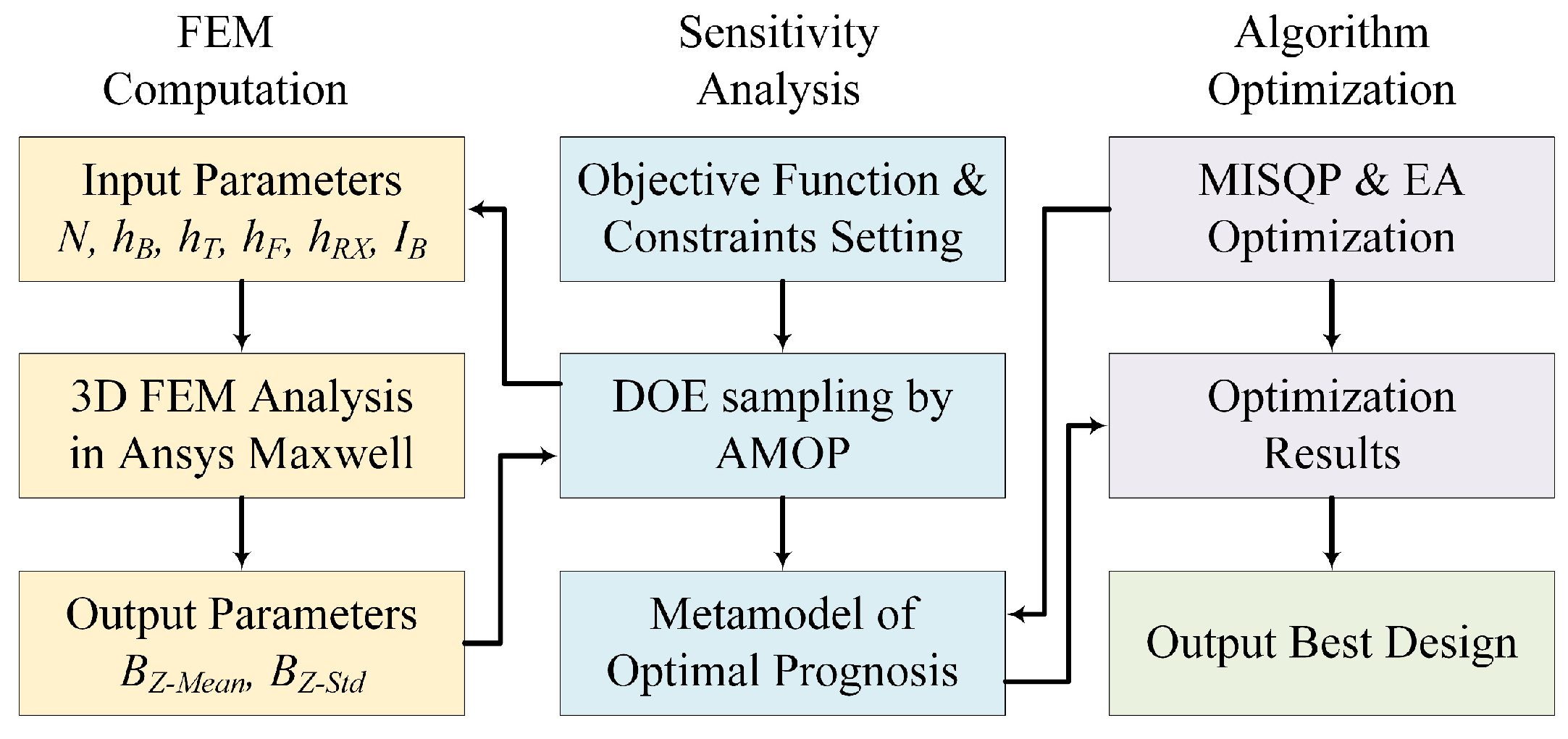
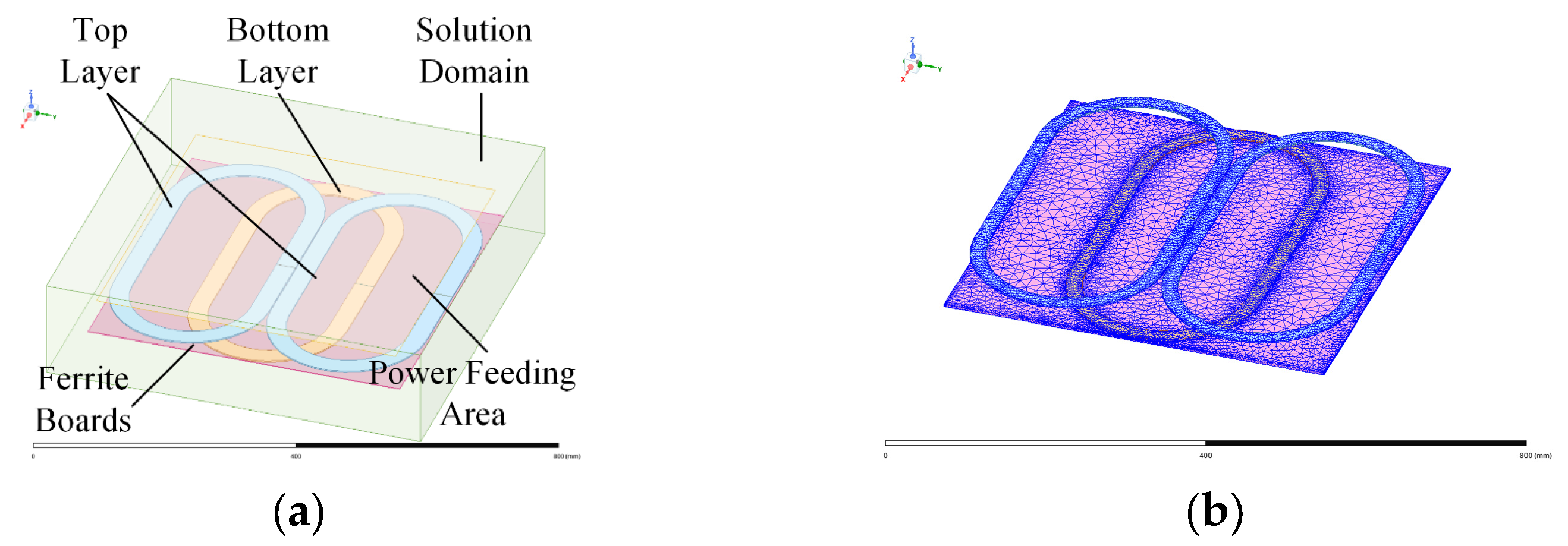

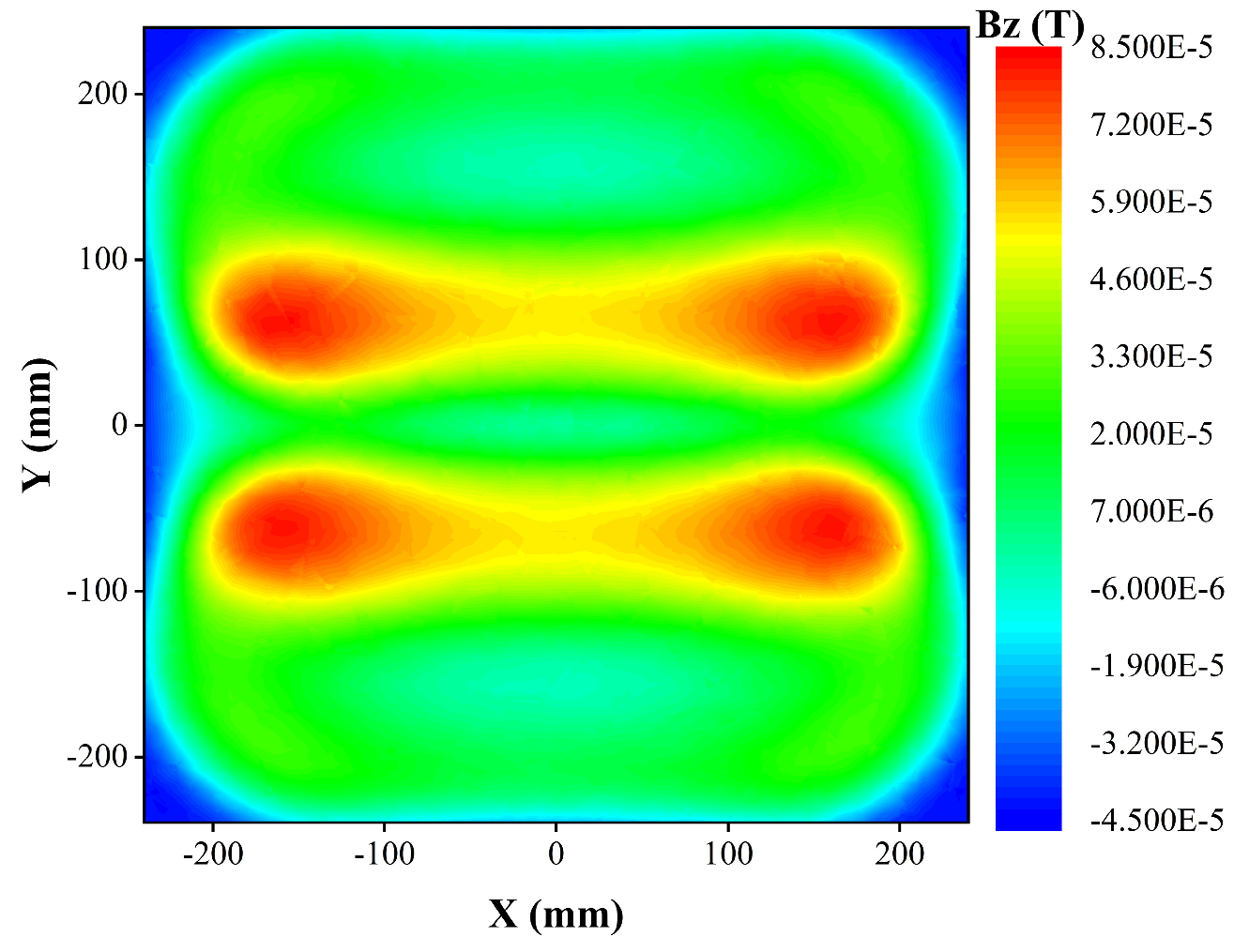
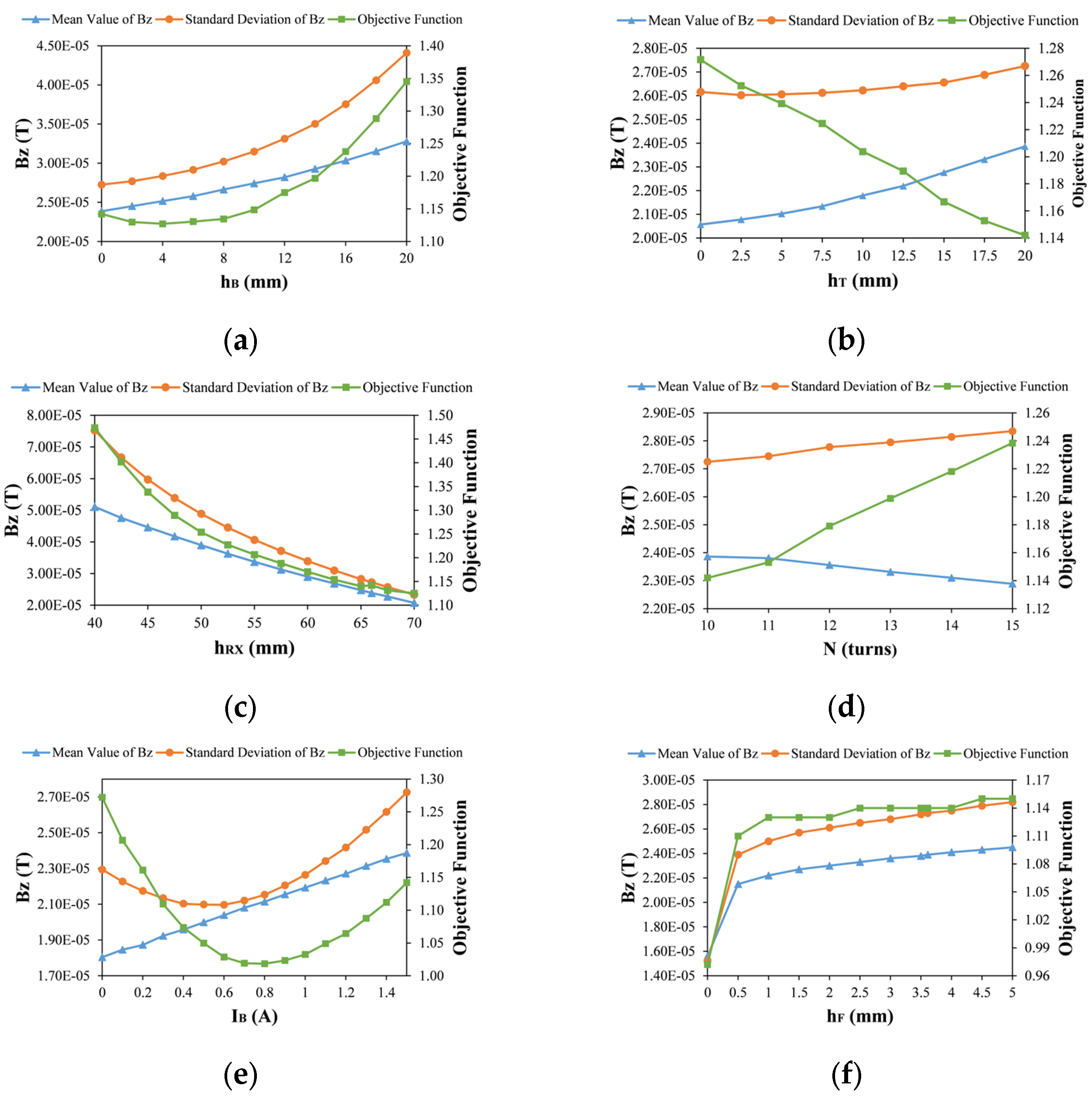


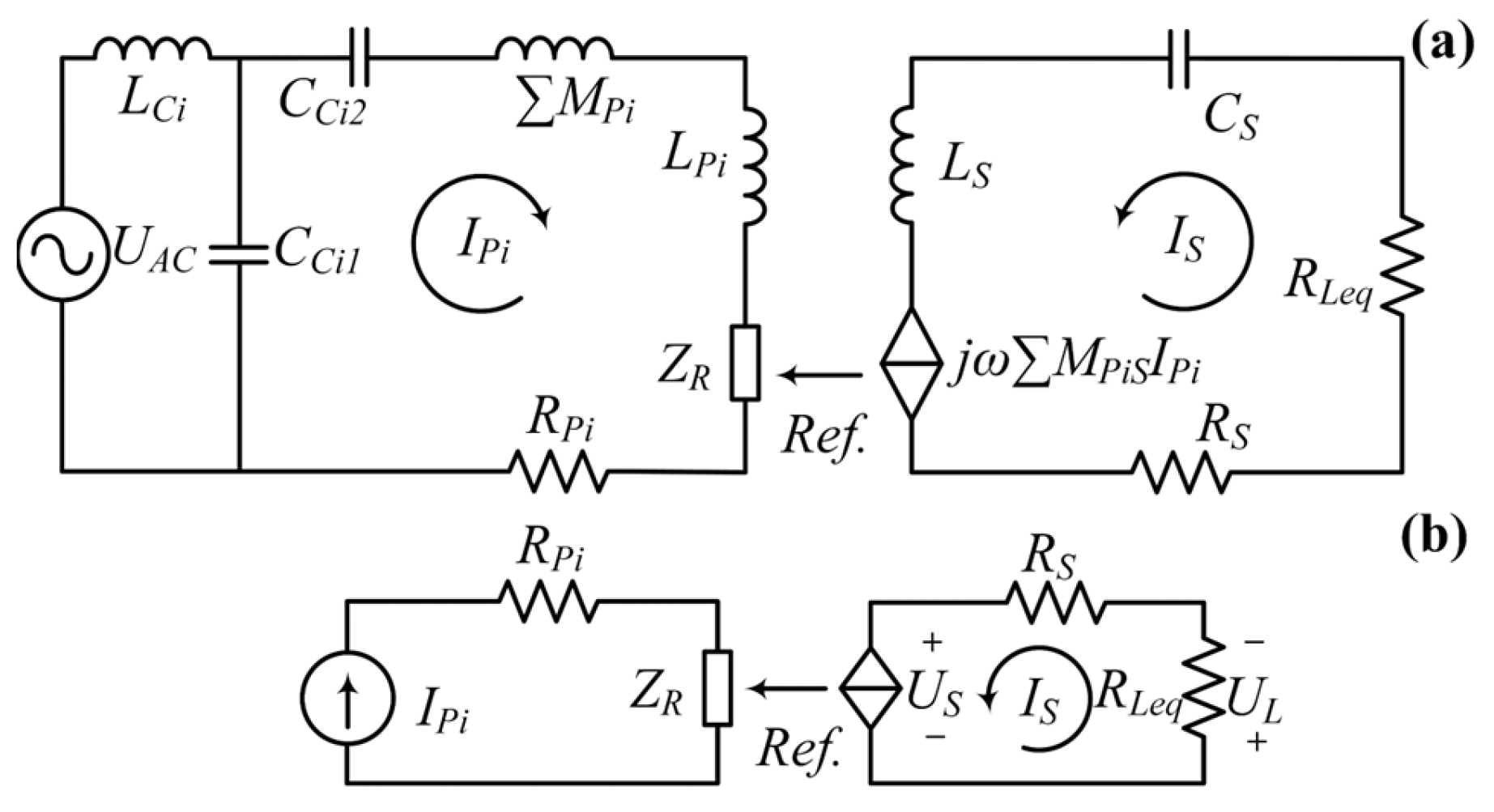
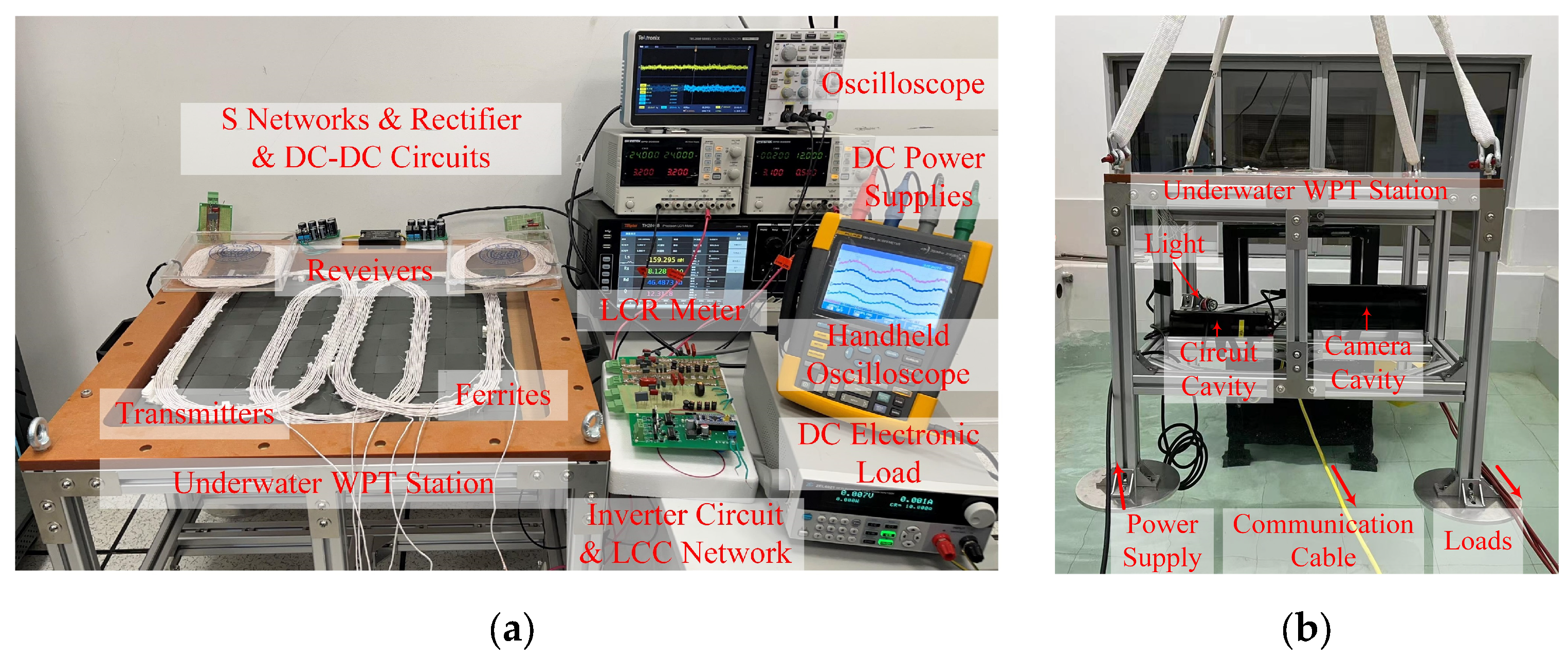
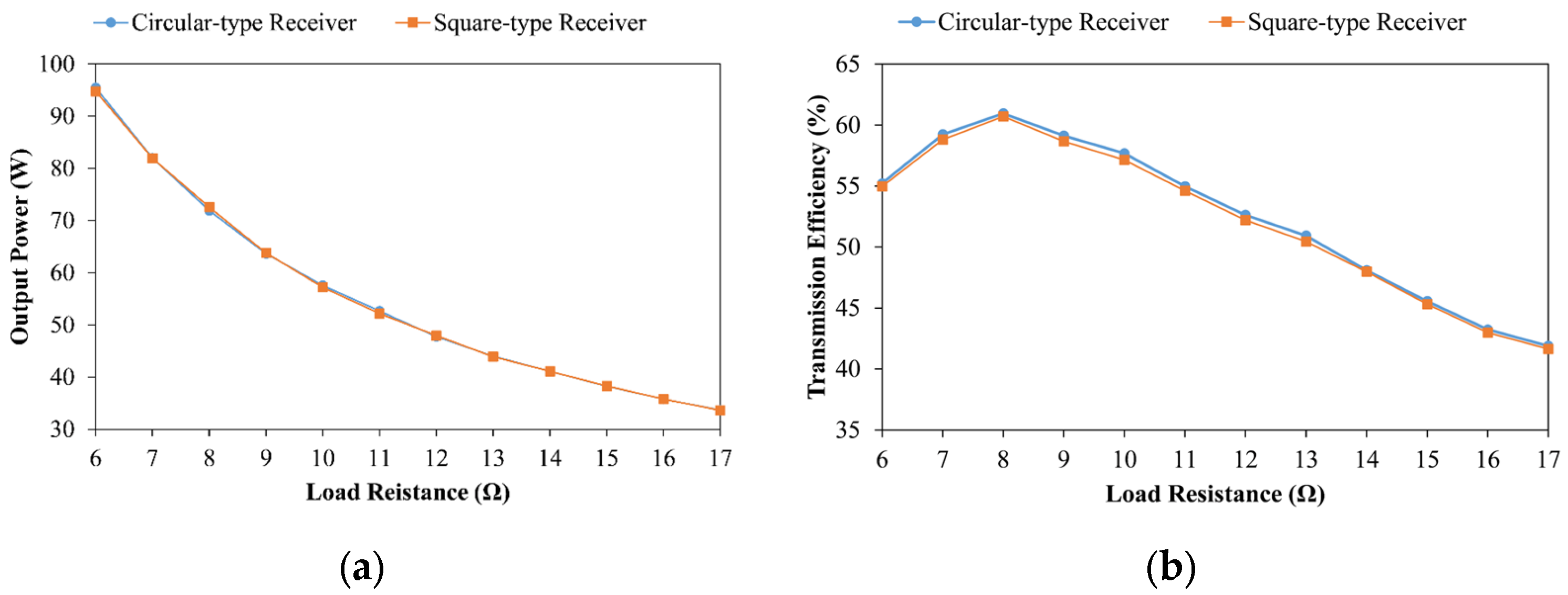


| Reference | Output Power | Operating Frequency | Overall Efficiency | Compatibility | Loads |
|---|---|---|---|---|---|
| [13] | 200 W | —— | 79% | Low | AUV |
| [16] | 416 W | —— | 47% | Low | AUV |
| [17] | 250 W | 50–125 kHz | 70% | Low | Mooring profiler |
| [20] | 300 W | 147 kHz | 85% | Low | Camera and light |
| [22] | 20 mW | 100 kHz | 63% | High | —— |
| [23] | ~67 W | ~88.5 kHz | 50% | High | AUV |
| This paper | 100 W | 100 kHz | 61% | High | CSO equipment |
| Parameters | Definitions | Values or Ranges |
|---|---|---|
| Din | Inner diameter of the runway-structure coils | 190–210 mm |
| Dout | Outer diameter of the runway-structure coils | 250 mm |
| LS | Length of the side of the runway-structure coils | 250 mm |
| N | Number of turns of the runway-structure coils | 10–15 |
| hT | Relative height of the top coil layer | 0–20 mm |
| hB | Relative height of the bottom coil layer | 0–20 mm |
| hF | Height of the ferrite board layer | 0–5 mm |
| LF | Length of the ferrite board layer | 500 mm |
| hRX | Height to the power feeding area | 40–70 mm |
| IT | Currents in the top layer coil | 1.5 A |
| IB | Current in the bottom layer coil | 0–1.5 A |
| Parameters | Initial Values | Optimized Values |
|---|---|---|
| N | 15 | 10 |
| hT (mm) | 0 | 20 |
| hB (mm) | 0 | 0 |
| hF (mm) | 0 | 3.6 |
| hRX (mm) | 40 | 66 |
| IB (A) | 1.5 | 1.5 |
| BZ-Mean (T) | 2.06 × 10−5 | 2.39 × 10−5 |
| BZ-Std (T) | 2.62 × 10−5 | 2.72 × 10−5 |
| F(v) | 1.27 | 1.13 |
| Parameters | Values | Parameters | Values |
|---|---|---|---|
| LP1 | 134 uH | MP1P2 | 6 uH |
| LP2 | 112 uH | MP2P3 | 15 uH |
| LP3 | 106 uH | MP1P3 | 15 uH |
| LC1, LC2, LC3 | 48 uH | LSquare | 74 uH |
| CC11, CC21, CC31 | 53 nF | CSquare | 34 nF |
| CC12 | 20 nF | RSquare | 0.25 Ω |
| CC22 | 25 nF | LCircular | 82 uH |
| CC32 | 24 nF | CCircular | 31 nF |
| RP1 | 0.43 Ω | RCircular | 0.29 Ω |
| RP2 | 0.42 Ω | f | 100 kHz |
| RP3 | 0.41 Ω | UDC | 48 V |
Disclaimer/Publisher’s Note: The statements, opinions and data contained in all publications are solely those of the individual author(s) and contributor(s) and not of MDPI and/or the editor(s). MDPI and/or the editor(s) disclaim responsibility for any injury to people or property resulting from any ideas, methods, instructions or products referred to in the content. |
© 2023 by the authors. Licensee MDPI, Basel, Switzerland. This article is an open access article distributed under the terms and conditions of the Creative Commons Attribution (CC BY) license (https://creativecommons.org/licenses/by/4.0/).
Share and Cite
Cai, T.; Lyu, F.; Wang, T.; Huang, F. Design of a Highly Compatible Underwater Wireless Power Transfer Station for Seafloor Observation Equipment. J. Mar. Sci. Eng. 2023, 11, 1205. https://doi.org/10.3390/jmse11061205
Cai T, Lyu F, Wang T, Huang F. Design of a Highly Compatible Underwater Wireless Power Transfer Station for Seafloor Observation Equipment. Journal of Marine Science and Engineering. 2023; 11(6):1205. https://doi.org/10.3390/jmse11061205
Chicago/Turabian StyleCai, Tianhao, Feng Lyu, Tianzhi Wang, and Fushi Huang. 2023. "Design of a Highly Compatible Underwater Wireless Power Transfer Station for Seafloor Observation Equipment" Journal of Marine Science and Engineering 11, no. 6: 1205. https://doi.org/10.3390/jmse11061205
APA StyleCai, T., Lyu, F., Wang, T., & Huang, F. (2023). Design of a Highly Compatible Underwater Wireless Power Transfer Station for Seafloor Observation Equipment. Journal of Marine Science and Engineering, 11(6), 1205. https://doi.org/10.3390/jmse11061205





